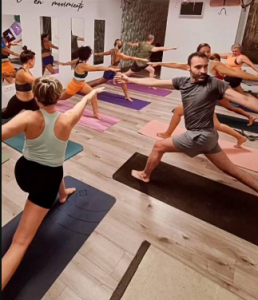
Yoga
Vol. 26, Issue 15, 02 Febrary 2024
Yoga is an ancient philosophical and spiritual practice that came from northern India. It is generally believed that it has existed for five thousand years, but some researchers suggest that the history of its development dates back about 10 thousand years.
For the first time, the word “yoga” is mentioned in the ancient sacred text of the Rig Veda and is translated as “connection”. According to the generally accepted theory, practitioners have put into the name the concept of the connection between the divine absolute and man, between mind and body. Over time, the perception of yoga was transformed, improved and then revealed in the Upanishads — ancient Indian religious and philosophical treatises. In the second century BC, Yoga sutras were written. Sutras are aphorisms in which the ancient Indian philosopher Patanjali described the eight basic steps of yoga.

There is an opinion that yoga is necessarily a spiritual practice, which causes fear among some believers. In fact, the first few steps relate to general moral principles, physical exercises and breathing practices. You can stop at them and practice yoga if you want to focus on the training side of the process.
The main types of yoga:
- Hatha yoga. This is a classic yoga practice in the modern sense. The word “hatha” means intensity. This type involves following the technique of tuning asanas and performing them in a certain sequence, as well as proper breathing to achieve body strength and mind harmony.
- Vinyasa. This type of yoga involves a smooth and consistent change of asanas. Unlike hatha yoga, here one pose naturally and continuously follows from another, asanas are complemented by breathing.
- Ashtanga vinyasa yoga. This is a system of hatha yoga, which is a dynamic practice of asanas connected to each other. The complex is performed in conjunction with pranayama — breathing, and bandhas — internal locks in the body, which are created by holding the breath in a certain way and release or stop energy in the body.
- Yoga nidra. The so—called yoga for sleep is the practice of consciousness, which, thanks to concentration on various objects, allows you to calm down and relax, which allows you to improve the quality of sleep.
- Kundalini. This is a yoga practice where each asana and each physical exercise have one goal — raising energy through the main seven chakras. The focus is on the spiritual component, and the lesson includes mandatory meditation and chanting mantras.
Yoga is a variety of physical activities. It includes all the main types of loads: cardio, strength and balance. Studies have shown that regular active training, including some types of yoga, such as strength training, reduces the risk of premature death by 44%. Yoga has a positive effect not only on the body, but also on mental health. For example, breathing exercises and relaxation practice at the end of a workout calm the nervous system, which, with regular exercise, has a beneficial effect on the psychological state of a person.

Yoga in the long term helps to reduce the risk of inflammatory processes and maintains a healthy body in old age. Regular practice also improves cognitive function and slows down the progression of Alzheimer’s disease.
- New Year’s mood - 22nd November 2024
- Minimalism is a way of life. Where to begin? - 15th November 2024
- Why do you need an air humidifier? - 8th November 2024
